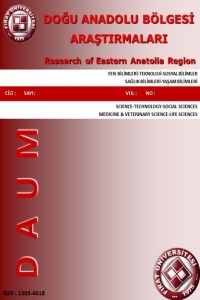ORMAN MERA İLİŞKİSİ
Orman Merası, Geçiş Merası, Otlatma, Yem Üretimi
___
- 1. Allen, B.H., 1988. Vegetation Science Applications For Rangeland Analysis And Management, (Ed. P.T.Tueller), Kluwer Academic Publichers, London, 339-362.
- 2. Andiç, C., 1993. Tarımsal Ekoloji, Atatürk Üniversitesi Ziraat Fakültesi Ders No: 106, 300p.
- 3. Anonymous, 1978. Toprak Su Genel Müdürlüğü Toprak Etüd ve Haritalama Daire Başkanlığı Yay., Ankara.
- 4. Anonymous, 2001. Türkiye İstatistik Yıllığı. Başbakanlık Devlet İstatistik Enstitüsü, Ankara.
- 5. Bakoğlu, A., Koç, A ve Gökkuş, A., 1999. Erzurum yöresi çayır ve meralarındaki yaygın bitki türlerinin ömür uzunluğu, çiçeklenmeye başlama tarihi ve ot kalitesi ile ilgili bazı özellikleri, Tr. J.of Agriculture and forestry, 23, 4, 951-957.
- 6. Bakır, O, 1987. Çayır Mera Amenajmanı, Ankara Üniversitesi Ziraat Fakültesi Yay.No: 992, 362p.
- 7. Bentley, J.R., Carpenter, S.B.and Blakeman, D.A., 1971. Early brush control promotes growth of ponderosa pine planted on a bulldozed site, USDA Forest Service Research Note PSW, 238.
- 8. Enger, E.D., Kormelink, J.R.,Smith, B.F and Smith, J.R., 1989. Enviromental Science, The Study of Interrelationships (Third Ed.) W.M.C. Brown Publishers, Dubuque, Iowa, 540p.
- 9. Fulgham, K.O., 1985. Plantation grazing in southcentral Oregon, In 7th Annual Forest Vegetation management Conferance, Society of American Foresters, Eureca, CA.
- 10. George, W.P., Pıtt, M.D.and Wikeen, B.M., 1994. Effect of forage seeding an early growth survival of loggopole pine, J.Range Management, 47, 379-384.
- 11. Hedrick, D.W.,.Young, J.A., McArthur, J.A.and Keniston, R.F., 1968. Effects of forest and grazing prastices on mixed coniferous forests of Northeastern Oregon, Oregon Agricultures Experiment Station Bull, 103.
- 12. Holway, J.G, and Hard, R.T, 1965. Phenology of alphine plants in orthern Colorado, Ecology, 46, 72-83.
- 13. Hubbard, A.C. and Ward, R.T.,1961. Grass reduces Bitterbrush Production, California Fish and Game, 47,4,391-398.
- 14. Karaşahin, H, 1990. Orman İçi Meralar, Tarım Orman ve Köy İşleri Bakanlığı, 51, 19-21.
- 15. Kasco, B.H. and Bartoleme, J.W., 1983. Effects of cattle and deer on regenerating mixed conifer clearcuts. J.Range Management, 36,2, 265-268.
- 16. Koç, A., Gökkuş, A, ve Serin, Y., 1994. Türkiye ’de çayır-meralarının durumu ve erozyon yönün-den önemi, Ekoloji Çevre Dergisi, 13, 36-41.
- 17. Mclean, A. and Clark, M.B., 1980. Grass, trees and clearcut-logged areas, J.Range management, 33,3,213-217.
- 18. Pearson, C.A., 1974. Range and Wildlife Opportunities, USDA Forest Service, 19-27.
- 19. Potton, C.A., 1974. Patch cutting increases deer an delk use of a pine forest in Arizona, J. Forestry, 72,12,876-895.
- 20. Reid, R. and Wilson, G., 1985. Agroforestry in Australia and New Zealand Goddard and Dobson Co., Box Hill. Victoria.
- 21. Roy, D.F., 1981. Effects of competing vegetation on conifer performance, In Forest Vegetaton Workshop, Oregon State Üniversity, Corvallis, OR.
- 22. Sharrow, S.H. and Leininger, W.C., 1982. Forage preferences of herded sheep as related to brush control and seasonal browsing damage to Douglasfir regeneration, Oregon State Üniversity Agriculture Expt.Stat., 56, Corvallis, OR.
- 23. Sharrow, S.H. and Rhodes, B., 1982. The effect of grazing sheep on clearcuts in Oregon’s coast range and its impact on big game habitat, Oregon Agriculture Experiment Station Project Progress reporet, 66, Corvallis, OR.
- 24. Skovlin, J.M., Harris, R.M., Stricler, G.S and Garrison, G.A., 1976. Effects of cattle grazing methods on ponderosa pine-bunchgrass range in the Pasific Nortwest, USDA Forest Service Bull 1531,40.
- 25. Thomas, G.B., Larry, W.V., Lytle, H.B., Thomas, J.F.and Sharon, C.H, 1990. Macro and trade mineral content of selected South Texas deer forages, J. Range Management, 43,3,220-223.
- 26. USDA., 1986. Vegetation management for reforestation Pasific Southwest Region, Forest Service, San Fransisco, CA, 500.
- 27. Vallentino, F.J, 1989. Range Development and Improvements, Academic Publichers Inc. 524p.
- 28. Walstad, J.D and Kuch, P.J. , 1987 Introduction to forest vegetation management, New York, Forest Vegetation Management for Conifer Production, 3-14p.
- ISSN: 1303-4618
- Başlangıç: 2002
- Yayıncı: Fırat Üniversitesi
ÖĞRETİM MATERYALİ OLARAK KAVRAM HARİTALARI
Mehmet ÇİFTÇİ, Bestami DALKILIÇ, Talat GÜLER, Osman Nihat ERTAŞ, Halil ÇERÇİ
ASENKRON MOTORUN VEKTÖR KONTROLÜNDE HOPF ÇATALLAŞMASI VE KAOS
Murat ELİÖZ, Murat KALDIRIMCI, Abdullah CANİKLİ, Yonca Süreyya BİÇER, Mehmet ÇEBİ, Cenk GÜRKAN
SALDIRGANLIĞIN PSİKOLOJİK-KÜLTÜREL BOYUTU VE VANDALİZM
Yener ÖZEN, Fikret GÜLAÇTI, Yahya ÇIKILI
BAZI TOPRAK VE BİTKİ ÖRTÜSÜ ÖZELLİKLERİ ARASINDAKİ İLİŞKİLER
BİR ALMAN ÇOBAN KÖPEĞİNDE BAĞIRSAK OBSTRÜKSİYONU VE OPERATİF SAĞALTIMI
Ali Said DURMUŞ, Murat DABAK, Ömer KIZIL
MUŞ VE YÖRESİNDEKİ SIĞIRLARDA GÖRÜLEN AYAK HASTALIKLARININ PREVALANSI ÜZERİNE ARAŞTIRMALAR
